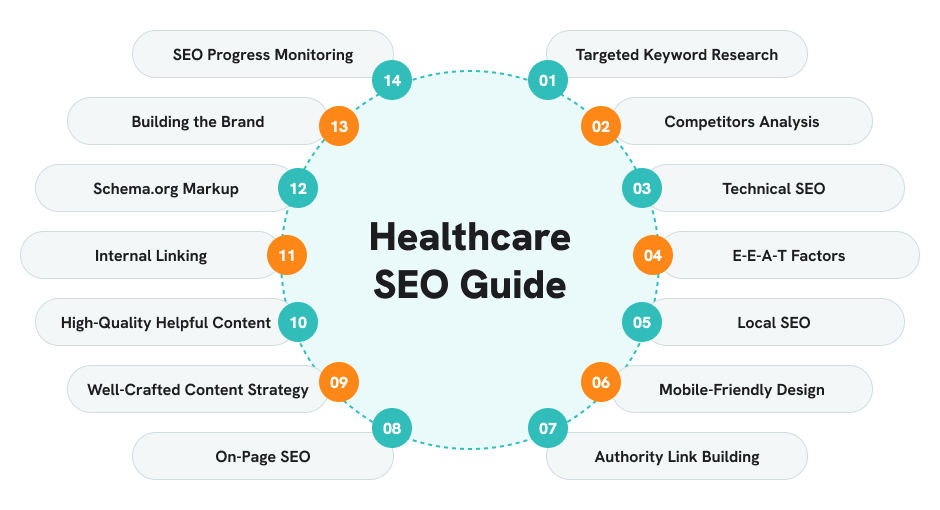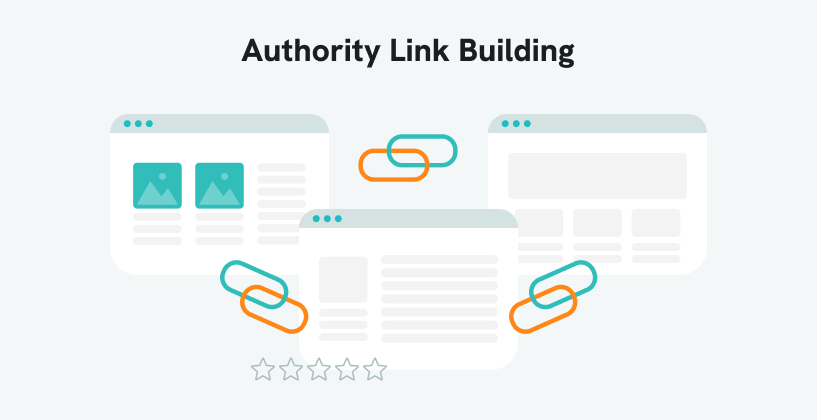Connecting with patients is vital for any medical practice. Healthcare SEO is designed to meet the unique needs of the healthcare niche, making it easy for patients to find your services. Effective SEO boosts online visibility, builds trust, and drives patient engagement and acquisition. This guide explores key aspects of medical search marketing and offers practical tips to optimize your healthcare website.
What Makes Medical Search Marketing Unique?
Medical search marketing stands out due to its specialized approach tailored to the healthcare industry. Unlike general SEO, medical search marketing focuses on connecting healthcare providers with patients seeking medical services, advice, and information. Several key factors contribute to its uniqueness:
1. Patient-Centric Approach
Understanding patient behavior and search patterns is critical. Patients often search for specific symptoms, treatments, and healthcare providers. Effective medical search marketing anticipates these needs, providing relevant and timely information. This approach not only drives traffic but also enhances patient engagement and trust.
2. Compliance with Regulations
Healthcare is a highly regulated industry, with strict guidelines governing the dissemination of medical information. Healthcare SEO must adhere to regulations such as HIPAA (Health Insurance Portability and Accountability Act) to ensure patient privacy and data security. Compliance extends to the accuracy and reliability of medical content, which must be regularly updated to reflect the latest medical standards and best practices.
3. Local SEO Focus
Many patients search for healthcare services within their local area. As such, local SEO is a critical component of medical search marketing. Optimizing for local search terms, ensuring accurate and consistent listings in local directories as a part of a local pack, and actively managing patient reviews are essential strategies to attract local patients and increase your positions on search engine results pages.
4. Reputation Management
In healthcare, trust is paramount. Online reviews and patient testimonials significantly influence potential patients‘ decisions. Effective reputation management for healthcare involves monitoring and responding to reviews, encouraging satisfied patients to leave positive feedback, and addressing negative reviews constructively.
5. Medical Content Accuracy
Providing accurate and up-to-date medical information is non-negotiable. Quality content not only boosts SEO for the healthcare industry but also establishes authority and patient trust. It’s crucial to avoid misleading information, as this can harm patient trust and even lead to legal repercussions. Integrating healthcare SEO services ensures that this content reaches a broader audience effectively.

Why Is Medical SEO Important in the Healthcare Industry?
SEO plays a vital role in the healthcare business for several reasons:
1. Increased Online Visibility
With millions of health-related searches conducted daily, appearing at the top of search engine results can significantly increase a healthcare provider’s visibility. High search rankings mean more exposure to potential patients, which can lead to increased appointments and consultations.
2. Patient Acquisition
Effective SEO strategies help healthcare professionals attract new patients by making it easier for them to find relevant services and information. By targeting specific keywords and phrases that potential patients are searching for, healthcare professionals can connect with individuals who are actively seeking their health services.
3. Trust and Credibility
High search engine rankings and positive feedback enhance a healthcare provider’s credibility. Patients are more likely to trust and choose providers who appear at the top of search results and have positive reviews from other patients.
4. Cost-Effective Marketing
Compared to traditional healthcare marketing methods, SEO offers a cost-effective way to reach a broad audience. Once a website is optimized, it continues to attract organic traffic without the ongoing costs associated with paid advertising.
5. Competitive Edge
The healthcare industry is highly competitive, with numerous providers vying for patients’ attention. Effective medical SEO strategies help healthcare professionals stand out from the competition by improving their online presence and making it easier for potential patients to find them.
Tips to Optimize Your Website
Optimizing a medical website involves several strategies to improve search engine rankings and enhance the user experience. Here are some essential tips:
1. Think of Your Patients and the Search Terms They Use to Find Medical Professionals

Understanding the keywords and phrases patients use when searching for medical services is the foundation of effective medical SEO. Use a keyword research tool like Google Keyword Planner or Ahrefs to do keyword research. Consider the following:
- Symptoms and Conditions: Identify common symptoms and conditions related to your professional practice and create content related to these topics.
- Treatments and Procedures: Optimize website content for specific treatments or procedures you offer.
- Local Searches: Include location-specific terms to capture local search traffic.
By focusing on these areas, you can create content that meets patients’ needs and improves your search engine rankings.
2. Make Sure Search Engines Can Crawl and Index Your Website

Ensuring that search engines can easily crawl and index your website is crucial for SEO success. Here are some key steps:
- Create a Sitemap: A sitemap helps Google understand the structure of your website and find all your pages.
- Use Robots.txt File: This file instructs an indexing service which pages to crawl and which to ignore.
- Fix Broken Links: Regularly check for and fix broken links, as they can hinder crawling and indexing.
By making your website easily accessible to Google searches, you improve your chances of ranking higher in search results.
3. Make Your Website Mobile-Friendly

With the majority of searches now conducted on mobile devices, having a mobile-friendly website is essential. Implement a responsive design to ensure your site looks and functions well on all devices. Google also prioritizes mobile-friendly sites in its rankings.
4. Improve Your Website’s Page Experience
Page experience includes ranking factors like website speed, page load time, interactivity, and visual stability. Focus on the following areas of technical SEO:
- Site Speed: Use tools like Google PageSpeed Insights to identify and fix site speed issues. Fast-loading pages can improve rankings.
- User Interface: Ensure your site is easy to navigate and visually appealing. A well-designed site keeps users engaged and encourages them to explore more pages.
- Accessibility: Make your site accessible to all users, including those with disabilities. This includes using alt text for images, providing transcripts for videos, and ensuring your site is navigable with a keyboard.
5. Focus on Earning a High EEAT Ranking
EEAT stands for Experience, Expertise, Authoritativeness, and Trustworthiness. Google values content that demonstrates high EEAT, especially as a part of SEO for medical websites. To improve your EEAT:
- Experience: Show that your content is created by those with direct, firsthand experience. Use author bios, personal references, and behind-the-scenes content.
- Expertise: Demonstrate expertise with accurate, in-depth content, author credentials, and reputable citations.
- Authoritativeness: Build authority by consistently publishing quality content, earning mentions from respected sites, and growing your industry reputation.
- Trustworthiness: Be transparent about authors, provide clear contact information, maintain a positive reputation, and follow ethical content SEO practices.
6. Adhere to Google’s YMYL Guidelines
YMYL (Your Money or Your Life) pages are those that can impact a person’s future happiness, health, financial stability, or safety. Healthcare websites fall into this category. To comply with YMYL guidelines, prioritize content quality by providing accurate, well-researched, and reliable information. Google scrutinizes YMYL pages more closely, so high-quality content is essential.
Additionally, maintain transparency by clearly displaying your practice’s contact information and privacy policies, which builds trust with patients and search engines. Regularly monitor and address patient reviews and feedback. Positive feedback improves your reputation, while addressing negative feedback demonstrates your commitment to patient satisfaction.
7. Build Your Website’s Authority
Building your website’s authority is a crucial step in establishing a strong online presence in the healthcare sector. Authority is not just about having a website; it’s about creating a trusted and reliable resource that both search engines and users recognize as a leader in the field. Here are some effective strategies to build and maintain your website’s authority.
7.1 Consistent Content Updates
Regularly updating your content is essential for maintaining authority. Medical information evolves, and your content must reflect the latest standards and practices.
- Review and Update: Periodically review existing content to ensure it remains accurate and up to date.
- Evergreen Content: Create content that remains relevant over time, with only minor updates needed to keep it current.
7.2 Engage with Patients
Engagement with your audience is crucial for building trust and authority as a part of SEO practices:
- Respond to Comments and Reviews: Actively engage with patients by responding to comments on blog posts and reviews on various platforms. This shows that you value their feedback and are committed to providing excellent care.
- User-Generated Content: Encourage patients to share their experiences and testimonials. Positive patient stories can significantly enhance your site’s credibility.
8. Authority Link Building

Link building is a cornerstone of SEO for hospitals, involving the acquisition of backlinks from reputable websites. These backlinks act as endorsements, signaling to search engines that your site is a trusted authority in the medical field.
8.1 Guest Blogging
Guest blogging as a part of the healthcare SEO strategy on authoritative medical websites is an effective way to earn high-quality external links:
- Identify Relevant Websites: Look for reputable websites in the medical industry that accept guest posts.
- Provide Value: Ensure your guest posts offer valuable insights and information that appeal to the audience of the host site.
8.2 Collaboration with Medical Organizations
Collaborating with a well-known healthcare organization can help you gain valuable backlinks:
- Partnerships: Establish partnerships with healthcare organizations and associations, universities, and research institutions. Joint ventures and collaborations can lead to backlinks from highly authoritative sources.
- Research Publications: Participate in or contribute to medical research studies and publications. Getting your work published in reputable journals can provide significant website SEO benefits.
8.3 Content Sharing
For medical link building, creating content that others find valuable and want to share can naturally attract backlinks:
- Infographics and Videos: Develop informative and visually appealing infographics and videos. Other websites frequently share these, creating valuable backlinks.
- Comprehensive Guides: Write in-depth guides on medical topics. These can become go-to resources for others and attract backlinks from reputable medical sites.
9. Do Content Marketing

Content marketing involves creating and distributing valuable content to attract and engage your target audience and make you appear higher on the results pages. In the healthcare sector, this means providing valuable information that patients find useful and informative.
9.1 Blogging
Regularly publishing posts on your blog on relevant medical topics as a part of your healthcare SEO strategy can drive traffic and improve SEO for healthcare providers:
- Address Patient Concerns: Write about common health concerns, treatments, and preventive measures. Addressing these topics shows that you understand and care about your patients’ needs.
- Seasonal Content: Create content around seasonal health issues, such as flu prevention tips in the fall. Timely content can attract significant attention and engagement.
9.2 Social Media Engagement
Social media is a valuable tool for distributing helpful content and engaging with your audience:
- Share Regularly: Post links to your blog articles, videos, and other content on social media platforms. Regular sharing keeps your audience engaged and informed.
- Engage with Followers: Respond to comments and messages. Active engagement shows that you care about your audience and are available to answer their questions.
10. On-site SEO
On-site SEO for medical practice involves optimizing various elements within your website to improve rankings and enhance the user experience.
10.1 Keyword Optimization
Use relevant keywords naturally throughout your content for search engine optimization. This includes placing the right keywords in title tags, meta descriptions, headers, and within the body text. Avoid keyword stuffing, as it can harm your SEO ranking. Or you can search for SEO services.
10.2 Meta Tags
Meta tags provide search engines with information about your webpage. Ensure that your title tags and meta descriptions are concise, relevant, and contain your primary keywords. This helps the indexing service understand the content of your pages and can improve your click-through rates.
10.3 Internal Linking
Internal links connect one page of your website to another, helping both users and indexing services navigate your site. Use descriptive anchor text that includes relevant keywords. An internal link can also help distribute page authority across your site, boosting the SEO of linked pages. Additionally, this can be done by SEO experts.
10.4 URL Structure
Clean, descriptive URLs help search engines understand the content of your pages. Use hyphens to separate words, and avoid using numbers or special characters. For example, a URL like “www.yourclinic.com/cardiology-services” is more SEO-friendly than “www.yourclinic.com/page1?id=123”.
10.5 Image Optimization
Optimize images by reducing file sizes for faster loading times and using descriptive file names and alt text. Alt text should describe the image and include relevant keywords, which helps with SEO for healthcare and makes your site more accessible to visually impaired users.
10.6 Mobile Optimization
With the ever-increasing use of mobile devices, ensuring your website is mobile-friendly is crucial. Use responsive design techniques to ensure your site looks and functions well on all devices. Google’s mobile-first indexing means that the mobile version of your site is considered the primary version.
11. Complete Your Google Business Profile
A well-optimized Google Business Profile (GBP) page is essential for your SEO, helping you attract patients in your geographic area.
11.1 Accurate Information
Ensure that all information on your business profile is accurate and up to date, including your business name, address, phone number, and hours of operation. Inconsistent information can confuse future patients and harm your organic search rankings.
11.2 Categories
Choose the appropriate categories for your practice. Accurate categorization helps Google understand your services and display your listing for relevant searches.
11.3 Photos
Upload high-quality photos of your practice, staff, and facilities. Visual content can enhance your listing and attract more clicks.
11.4 Reviews
Encourage satisfied patients to leave positive reviews on your Google Business page. Respond to reviews, both positive and negative, to show that you value patient feedback about medical professionals and are committed to improving their experience.
12. Offsite Factors
Offsite SEO involves activities outside of your website that can impact your rankings. Building a robust backlink profile is one of the most critical offsite SEO strategies.
12.1 Social Media Engagement
Active engagement on social media platforms can boost your offsite SEO. After healthcare content writing, share your content regularly, respond to comments and messages, and participate in relevant discussions. These platforms’ signals — such as likes, shares, and comments — can indirectly influence your search rankings.
12.2 Online Reviews
Managing online reviews on platforms like Google, Yelp, and Healthgrades is essential. Positive reviews can enhance your online reputation and attract more patients. Responding to reviews, both positive and negative, shows that you care about patient feedback and are committed to providing excellent service.
12.3 Local Citations
Ensure your practice is listed in local directories with consistent information. Local citations help improve your local rankings and make it easier for patients to find you. Consistency is key; make sure your name, address, and phone number (NAP) are the same across all listings as part of the Google Local Pack.
13. Monitor Your Healthcare Professional SEO Progress
Regularly monitoring your SEO progress is crucial to understanding what’s working and what needs improvement. Use tools like Google Analytics, Google Search Console, and SEMrush to track key metrics such as search engine traffic, keyword rankings, and bounce rates.
13.1 Organic Traffic
Track the number of visitors coming to your site from the indexing service. An increase in organic traffic is a good indicator that your SEO efforts are paying off.
13.2 Keyword Rankings
Monitor how well your site ranks for your target keywords. Track changes in rankings over time to see which keywords are performing well and which need more attention.
13.3 Bounce Rate
The bounce rate indicates the percentage of visitors who leave your site after viewing only one page. A high bounce rate can signal that your content isn’t meeting user expectations or that your site has usability issues.
13.4 Conversion Rate
Track the percentage of visitors who take a desired action on your site, such as booking an appointment or filling out a contact form. A high conversion rate indicates that your site is effectively driving patient engagement.
14. Benchmark Your Healthcare SEO and Compare Performance to Your Competitors
Benchmarking involves comparing your SEO performance against that of your competitors to identify areas for improvement.
14.1 Identify Top Competitors
Determine who your main competitors are in the healthcare business. Look at their websites, content, and SEO strategies.
14.2 Analyze Keyword Usage
Examine the keywords your competitors are ranking for and how they are using them. Identify gaps and opportunities in your own keyword SEO strategy.
14.3 Backlink Profile
Analyze the number and quality of backlinks (your backlink profile) pointing to your competitors’ sites. Identify potential sources for backlinks that could benefit your site as well.
14.4 User Experience
Look at the overall user experience on your competitors’ sites. How easy is it to navigate their sites? Are they mobile-friendly? Use these insights to enhance the experience on your own site.
How Can the Healthcare Industry Benefit from Search Engine Optimization?
Search engine optimization enhances healthcare businesses by boosting online visibility, credibility, and patient engagement. High search rankings attract new patients by making healthcare professionals more visible. Additionally, higher-ranked websites are perceived as more authoritative and reliable, building trust and credibility.
An effective medical SEO strategy enhances patient engagement with fast-loading, mobile-friendly, and easy-to-navigate websites. It boosts patient acquisition by targeting relevant keywords, attracting visitors likely to convert into patients. Additionally, SEO is cost-effective, providing sustainable, long-term benefits without ongoing costs.
SEO offers insights into patient behavior, enabling informed decisions and service optimization. Local SEO boosts visibility in specific areas, attracting local patients. Overall, SEO helps healthcare professionals stand out, drive website traffic, and increase patient numbers.



